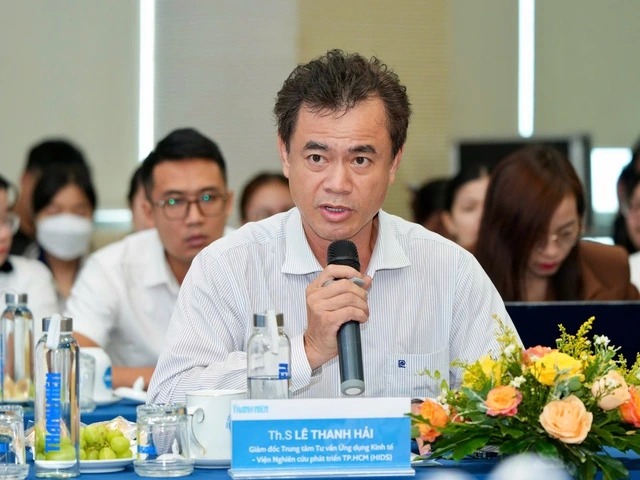 Society
Society


|
| Lê Thanh Hải, Director of the Center for Economic Application and Consulting under HCM City Institute for Development Studies (HIDS), speaks about his department's draft plan to switch all ride-hailing motorbikes in the city from petrol to electricity for Ride-Hailing and Delivery Drivers at the seminar on August 22. – Photo thanhnien.vn |
HCM CITY – To address the growing issue of air pollution in Việt Nam, it is essential to take urgent and robust actions to reduce net emissions and prevent harmful consequences, a seminar heard in HCM City.
The seminar titled "Reducing Emissions, Purifying the Air," organised by Thanh Niên (Young People) Newspaper on August 22, aimed to find solutions to cutting emissions and achieving the net-zero emissions goal by 2050.
Lâm Hiếu Dũng, Deputy Editor-in-Chief of the newspaper, stated that people are witnessing an increase in air pollution.
Even during HCM City's rainy season, when air quality is usually at its best, the sky is sometimes hazy due to pollution.
Meanwhile, Hà Nội frequently ranks among the world's most air-polluted cities.
Pollution also directly impacts other economic sectors such as tourism, agriculture, and industry.
According to the World Health Organisation (WHO), air pollution causes trillions of dollars in global economic losses annually.
Countries with high pollution levels face rising healthcare costs and a severe decline in labor productivity due to poor worker health.
Hoàng Dương Tùng, President of the Clean Air Network, said that air quality in Việt Nam is at an alarming level, with the air people breathe every day becoming one of the biggest threats to public health.
According to the Ministry of Agriculture and Environment, air pollution is increasing in many areas of Việt Nam, particularly in Hà Nội and HCM City, where the concentration of PM2.5 fine particulate matter on days of the year is higher than the permitted standard.
PM2.5 is a mixture of primary particles (dust, soot) and secondary particles (sulphates, nitrates, ammonia) formed from SO2, NOx, VOC, and NH3 in the atmosphere.
It is generated by fossil fuel-powered vehicles, fossil fuel use, open burning (of straw and rubbish), construction, and ammonia from agricultural sources.
This has led to increasing healthcare costs, economic damage, and policy pressure.
Each year, over thousands of deaths are related to air pollution.
Additionally, according to the WHO and the World Bank, economic damage caused by air pollution accounts for 5 to 7 per cent of the GDP.
Air pollution fluctuates by season and hour, peaking during the dry season and rush hour traffic, he added.
According to Ngô Nguyễn Ngọc Thanh, Deputy Head of the HCM City Environmental Protection Agency, the city has set emissions control targets for the 2020-2030 period, identifying transportation as the primary source.
However, she noted that other sources, such as industrial activity, construction, and the burning of agricultural by-products, must also be considered.
For HCM City specifically, the burning of agricultural by-products is not widespread, but the unregulated waste burning remains an issue in some areas and must be minimised.
Thanh emphasised that implementing emission control solutions is a must.
Air pollution is a regional issue and is very difficult to solve without the participation of the entire political and social system, she added.
“To effectively improve the situation, we need to 'green' all fields, not just transportation, but also agriculture, industry, and daily activities,” she added.
Lê Thanh Hải, Director of the Center for Economic Application and Consulting under HCM City Institute for Development Studies (HIDS), said his department submitted a draft plan to switch all ride-hailing motorbikes in the city from petrol-operated to electric vehicles for Ride-Hailing and Delivery Drivers.
From 2026, the city will begin the transition by banning new petrol motorbikes from registering for ride-hailing services.
Existing petrol motorbike drivers will have a three-year period, from 2026 to 2028, to switch to electric vehicles.
The goal is to convert 30 per cent of delivery drivers by 2026 and 50 per cent ride-hailing drivers by 2027.
The city plans to budget VNĐ50 billion (nearly US$1.9 million) to help 10,000-15,000 low-income drivers switch with support that will include interest-free loans, paid back with fuel savings, and tax exemptions.
By January 2029, all petrol motorbikes will be prohibited from ride-hailing and delivery services in HCM City centre.
Besides, businesses show great concern and propose adoption of support policies for drivers to shift to using electric vehicles.
Đặng Thùy Trang, Head of Public Affairs at Grab Vietnam, said Grab has been implementing its green transition plan for years.
Grab has partnered with local electric vehicle makers, integrated a charging station map into their app, and offered preferential loans for drivers.
However, to effectively transition, a complete ecosystem is needed.
This includes state-invested public charging stations, maintenance, and related financial services.
Moreover, drivers face several significant challenges in the transition to electric vehicles.
This includes the high cost of switching, which is compounded by the difficulty many face in securing loans due to a lack of permanent city residency.
Furthermore, about 80 per cent of drivers have no experience using electric vehicles.
They are also concerned about the limited and inconvenient public charging infrastructure, as well as the durability of the vehicles in challenging conditions, such as heavy rain or when carrying heavy loads.
Trang highlighted that the green transition is not just about changing vehicles, but about changing the livelihood of thousands of ride-hailing drivers.
Therefore, support policies must be more practical and comprehensive.
This includes expanding the conditions for loans, developing a public charging station network while avoiding monopolies, and promoting the production of electric vehicles specifically designed for transporting passengers and goods. – VNS